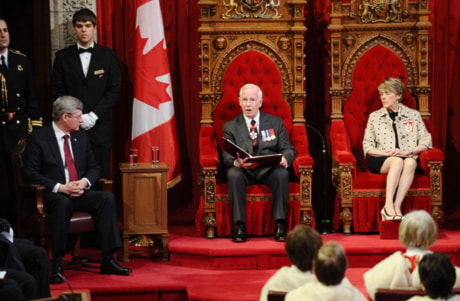OTTAWA — Whether or not you voted for the Conservative platform in the recent federal election, that’s what you’re getting.
The new majority Tory government laid out its agenda today in a throne speech that promises to focus on the economy while following through on some contentious plans to cut high-profile programs.
The speech vows to kill the long-gun registry, the per-vote subsidy for political parties, and the Canadian Wheat Board’s monopoly.
It also includes plans to reform the Senate, maintain health-care funding increases, and create a new Office of Religious Freedom to help protect minorities abroad.
Nearly everything in the 18-page document was also in the Tory platform, including a promise to soldier on with the tough-on-crime strategy. Even the title of the speech is a play on the party’s campaign pledge.
That document was called “Here for Canada.” The throne speech is titled “Here for all Canadians.”
However, there was nothing new in the plan that might appeal to those who didn’t vote for a Conservative regime, even as the Harper government pledged to work for them too.
“We will get back to work on the things that matter most to Canadians: good jobs, security for our families and a prosperous future,” Gov. Gen. David Johnston read in his first speech since becoming the viceroy last summer.
“Our government will be here for all Canadians — for individuals, for families and for all regions of the country — as together we move Canada forward.”
At least one person in the Senate chamber did not agree. A young woman dressed as a Senate page walked on the floor of the chamber during the speech and held up a red cardboard stop sign reading “Stop Harper.” She was escorted out without any fuss.
The speech also recommits to erasing Canada’s deficit by 2014 — a year earlier than scheduled — through government spending cuts. At the same time, it vows to move forward with a set of tax credits designed to ease the burden on caregivers and families.
The government will also move forward to reach a deal with Quebec on tax harmonization by Sept. 15.
Among the MPs, senators, Supreme Court justices and other dignitaries gathered in the Red Chamber for the speech was Shaun Atleo, national chief of the Assembly of First Nations.
Relations with First Nations were addressed in the speech.
“Concerted action is needed to address the barriers to social and economic participation that many Aboriginal Canadians face,” it read.
“Our government will work with aboriginal communities, provinces and territories to meet this challenge.”
Two of the longtime Tory goals outlined — killing the gun registry and the Wheat Board’s monopoly — will likely not be met until the fall session or beyond.
The main priority for the brief parliamentary session before the summer recess is to pass the federal budget, which is being introduced Monday. The Tories have pledged to reintroduce the same fiscal plan they outlined prior to the election.
Missing from the speech were the surprises that have characterized some previous Harper government documents, such as an ill-fated proposal last year to revise the national anthem.
Facts about the throne speech:
What: Offers an outline of the government’s plans and policies for a new session of Parliament.
Who: Read by the Governor General or, on rare occasions, by the Queen.
Where: Delivered in the Senate chamber because the Queen and her representatives are barred from the House of Commons.
History: The last time a monarch entered the Commons was in 1642, when King Charles I and armed supporters tried to arrest five MPs in the British House of Commons. He was rebuffed without finding the MPs and was later arrested, tried and beheaded.
Ceremony: After the Governor General is seated in the Senate, ritual requires that the Usher of the Black Rod (essentially the sergeant-at-arms of the Senate) march down the hallway to the Commons and hammer on the closed doors with his ceremonial cane to summon MPs. MPs follow the usher to the Senate, where they cluster behind the bar at the south end of the chamber to hear the speech.
